
|
[Maison Mercier]
[JJ Mercier]
[Our offices]
[Webcam]
[Interactive map]
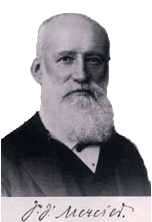 | The Château d'Ouchy | The lakeside companion to the Maison Mercier, the Château d'Ouchy was built by the same architect and the same developer. 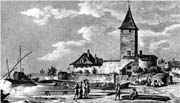
The Château d'Ouchy in 1780.
The renovations initiated by Mr. Mercier in the late
19th century integrated the 14th-century tower within
an architectural ensemble that was to become a hotel. 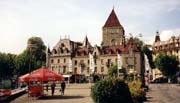
The Château d'Ouchy in 2000.
The Château d'Ouchy hosted the Lausanne Conference
(June 16 - July 9, 1932), better known as the Reparations
Conference. The aim was to find a solution to the serious
economic and financial difficulties that had shaken the global
economy ever since Black Thursday in 1929. In the early
summer of 1932, Germany was beginning to worry the Western
powers once again, and all eyes were on the German representatives,
Baron Konstantin von Neurath and Chancellor Franz
von Papen. The conference set an amount of three billion
marks to cover the reparations owed by Germany after the
First World War, a reduction of over 93 million from the
German war debt. Once this sum was paid, which should have
occurred before 1935, Germany would have been definitively
free of its debts. But Hitler's arrival to power in 1933 meant
that the balance of reparations owing was never paid. |
|
|
Jean-Jacques Mercier was a businessman unlike any other, who left a strong mark on the urban architecture of Lausanne. The Micheloud & Cie offices are located on the top floor of one of his most stunning accomplishments: the Maison Mercier. Born into a family of tanners established in Lausanne since 1740, Jean-Jacques Mercier (the third) began his career in the family business. Through marriage, this ambitious man with a strong character entered into the circle of old Lausanne families at a time when the mixing of milieus was rare. Heavily involved in politics, he was a member of the Lausanne town council between 1866 and 1879 and took part in elaborating the Vaud canton constitution. This exceptional businessman's career stands out from the others' through the diversity of his activities and by the mark he left on the city of Lausanne. His clear-minded, entrepreneurial approach was above all conveyed through the family business in the leather industry. A tanner for 43 years, Jean-Jacques Mercier was equally skilled in sales and manufacturing: under his direction, the family tannery that began in 1740 expanded to became one of the flagship industries of the Vaud during the second half of the 19th century. 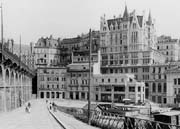
Gare du Flon and Maison Mercier circa 1900. (© MHVL) |
|
Jean-Jacques quickly understood the importance of the booming American market,
on which he was able to establish himself and turn a considerable profit on
the family business. With the wealth acquired in the tanning industry, he was
then able to diversify his activity and throw himself wholeheartedly into another
sector: the urban development of Lausanne, where he became one of
the city's most significant landowners. 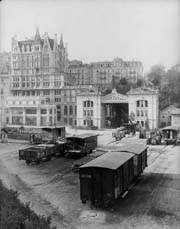
Gare du Flon and Maison Mercier circa 1900. (© MHVL) |
|
Principal developer of the metro that connected the Lausanne station to the Ouchy harbor in 1877, he took advantage of the ground excavated during the construction to fill in the Flon valley (at the heart of the city) and create an enormous lot for new buildings. He was thus quickly able to build a train station and set up a warehouse business. In 1884, he bought the state-owned Château d'Ouchy, an ancient residence for bishops of which there remained only a tower in ruins. After redeveloping the property, he had architect Francis Isoz transform the castle into a hotel, which was completed in 1893 and still exists today under the name of Château d'Ouchy. By 1893, Jean-Jacques Mercier was well-established in the realty sector and purchased the property at 8 Rue du Grand-Chêne. Once again, he called upon architect Francis Isoz to design a building unlike any other in Lausanne and which remains to this day the city's most striking monument: the Maison Mercier. [Maison Mercier]
[JJ Mercier]
[Our offices]
[Webcam]
[Interactive map] |

